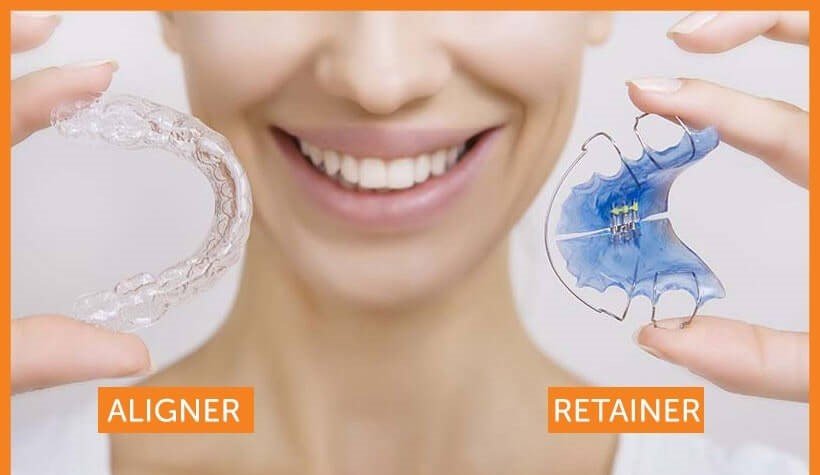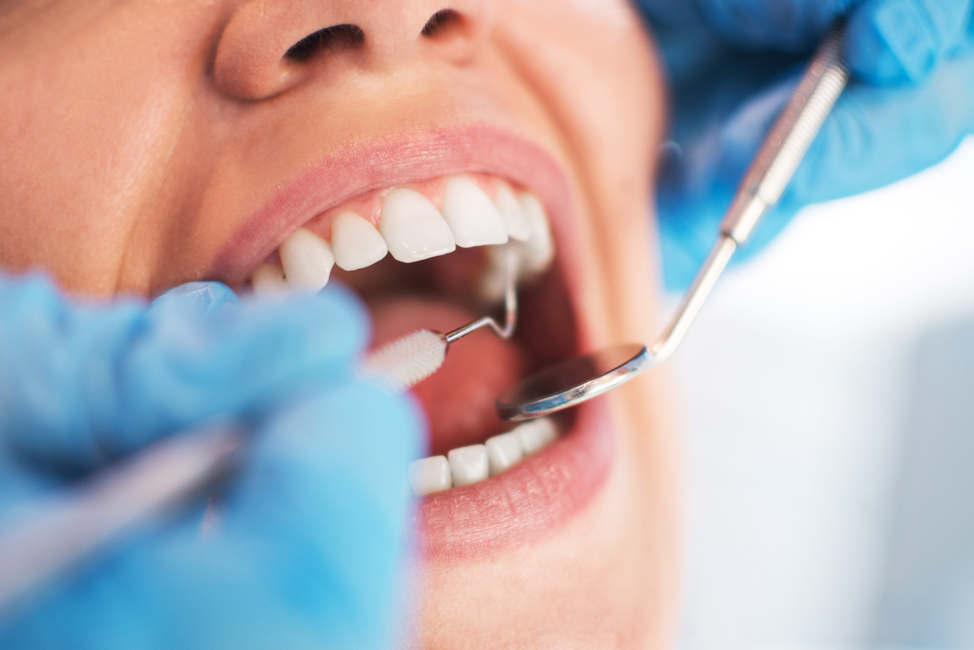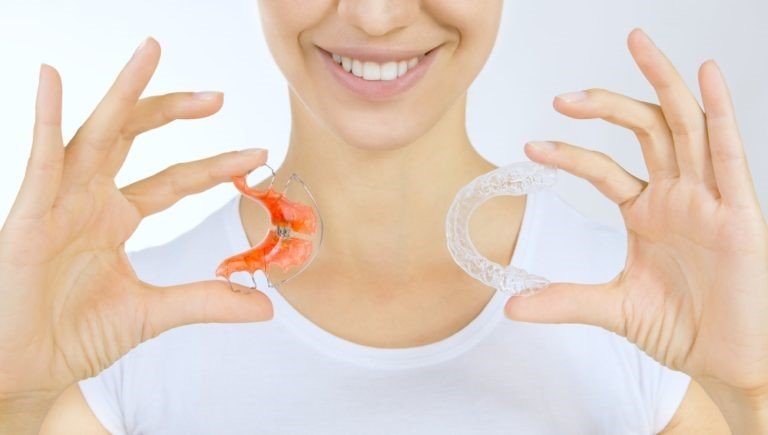Navigating post-orthodontic care can be as crucial as the treatment itself. Two mainstays dominate this phase: aligners vs retainers. Both serve distinct purposes in preserving the hard-earned alignment of teeth.
In this guide, we delve into the intricacies of aligners and retainers:
- Differences between aligners and retainers
- Similarities between aligners and retainers
- Importance of retainers after aligners
Aligners vs. retainers: differences
When comparing aligners vs retainers, it’s essential to understand their distinct roles in orthodontic treatment. Aligners are designed to move teeth into desired positions by applying gentle, consistent pressure, and are typically replaced every one to two weeks. In contrast, retainers are used post-treatment to maintain teeth in their new positions, preventing them from shifting back. While dental aligners actively correct tooth alignment, retainers ensure long-term stability. This fundamental difference highlights the sequential nature of their use in achieving and maintaining a perfect smile.
How they work
When discussing aligners vs retainers, it’s important to understand their roles in orthodontic treatment. Aligners are custom-made trays that apply gentle pressure to straighten teeth, much like traditional braces but with a clear, thermoplastic material. Patients typically wear a series of aligners, each designed to move teeth incrementally over a period of one to two weeks. In the realm of clear aligners, SmilePath and NewSmile are emerging as notable players, offering alternative options for those seeking orthodontic treatment.
Retainers, on the other hand, are used after the active phase of orthodontic treatment. They maintain the new position of teeth, preventing them from shifting back to their original alignment. Retainers can be fixed or removable, with removable options including wire-type or clear plastic trays.

Benefits
Aligners correct the alignment of teeth, improving both aesthetics and function. Conversely, retainers ensure the teeth remain in their new positions post-treatment, anchoring them firmly to prevent relapse. The primary distinction in the aligners vs retainers comparison lies in their treatment goals: aligners move teeth, while retainers stabilize them.
Treatment duration
Aligners must be worn for at least 22 hours daily, except when eating, drinking, or brushing teeth. After the teeth have moved to their desired positions, retainers are required. Initially, retainers are worn for 22-24 hours a day for around six months, then typically only at night (12-14 hours) indefinitely to maintain alignment.
Replacement
Aligners are replaced frequently, usually every one to two weeks, as each tray is designed for a specific amount of tooth movement. Retainers, in contrast, are worn for at least 3 to 6 months before potentially being replaced with new ones as needed.
Aligners vs. retainers: similarities
Both aligners and retainers share some similarities. Their fabrication process involves an orthodontic evaluation and a 3D scan of the teeth. Using this virtual model, aligners and retainers are crafted using treatment planning software. Both are suitable for children and adults, offering a comfortable fit due to their smooth plastic material.

Comfort and appearance
In terms of comfort, both aligners and retainers are made from smooth plastic, making them gentle on the gums and soft tissues of the mouth. They are clear and nearly invisible, making it hard to distinguish between the two if you’re not familiar with aligners vs retainers.
Usage stages in orthodontic treatment
Patients interested in straightening their teeth with clear aligners should consult their dentist or orthodontist. Once the active treatment phase is complete, new imprints of the teeth are taken to create retainers. These retainers then help maintain the teeth in their new positions.
Post-treatment retainer wear
Post-treatment, retainers must be worn for a minimum of 22 hours daily for the first 6 to 12 months to stabilize the teeth. This step is critical because the bone and surrounding tissues need time to adapt and solidify around the newly aligned teeth.
Oral hygiene and retainer care
To ensure the effectiveness of retainers, maintain proper oral hygiene by brushing retainers under running water and storing them in a designated container. Avoid harsh chemicals and follow your orthodontist’s instructions closely. Regular communication with your orthodontist will ensure that any necessary adjustments are made, supporting long-term dental health.

Why wear retainers after aligners?
Wearing retainers after aligners is crucial for maintaining the results achieved during orthodontic treatment. While aligners or braces exert pressure to shift teeth, they also trigger bone remodeling, reshaping the bone around the teeth. Even after aligners are removed and teeth reach their desired positions, the bone and surrounding tissues require time to fully adapt and stabilize. Without proper support during this phase, teeth may gradually revert to their original positions. Retainers ensure the newly formed bone solidifies and establishes a strong connection with the teeth, akin to allowing plants to take root in soil. This ensures long-term stability and prevents relapse.
Tips for wearing retainers
Follow instructions: Your orthodontist will provide specific guidelines for using your retainers. Adhering to these instructions diligently will yield better results.
Keep them clean: To maintain proper hygiene, clean your retainers by brushing them under running water and storing them in a designated container. Avoid leaving them in a napkin, as it may lead to accidental disposal. Remember to brush your teeth before wearing your retainers.
Ensure correct positioning: When placing your retainers, make sure they are positioned correctly before biting down. Incorrect positioning can cause gum injuries and damage to the retainers.
Avoid harsh chemicals: Refrain from using harsh chemicals like bleaching agents, mouthwash, baking soda, or toothpaste to clean your retainers as they may cause scratches. Additionally, avoid exposing your retainers to boiling water or dishwasher.
Regular dental visits: Schedule routine dental checkups to discuss any issues or concerns regarding your retainers with your dentist or orthodontist. Avoid attempting to adjust loose or tight retainers yourself, as this may cause permanent damage.
Conclusion
When considering aligners vs retainers, both are vital to orthodontic treatment. Aligners actively move teeth into their desired positions, while retainers keep them there. Adhering to your orthodontist’s guidelines for wearing and maintaining these appliances is crucial for achieving and preserving a perfect smile. Regular dental checkups are essential to address any issues with the fit or condition of your retainers.
FAQ
Do you need a retainer after spark aligners?
Yes. Spark aligners are a dental treatment that helps to strengthen and align teeth for proper biting. However, after the treatment, it is critical to use retainers to maintain the teeth in their new position. This is because without using retainers, there is a risk of malocclusion or the teeth moving back to their original position. Therefore, retainers are essential to ensure the success of the treatment and to keep the teeth aligned long-term.
Can I use my aligner as a retainer?
No. Aligners and retainers serve different purposes. Aligners are designed to shift the position of teeth by applying continuous pressure, while retainers are used to maintain teeth in their new position. As a result, the way they function is distinct.
Can I switch between aligners and retainers during post-orthodontic care?
Yes. It is possible to switch between retainers and aligners during post-orthodontic care, depending on the severity of the misalignment. If your teeth are in the correct position, it is recommended that you continue to wear a retainer. However, if your teeth shift out of alignment, you should contact your orthodontist who will likely prescribe an aligner to correct the issue and bring your teeth back into the right position.
Author of this blog post:
Anye Tchouli Calne Forkob Linkedin

Anye Tchouli Calne Forkob is a medical student at the University of Buea and a Health Sciences student at the University of the People. He is passionate about community health outreach, self-care, and healthy lifestyle and aims to bridge the knowledge gap in the health sector.
Published by Toothhealth Team.


